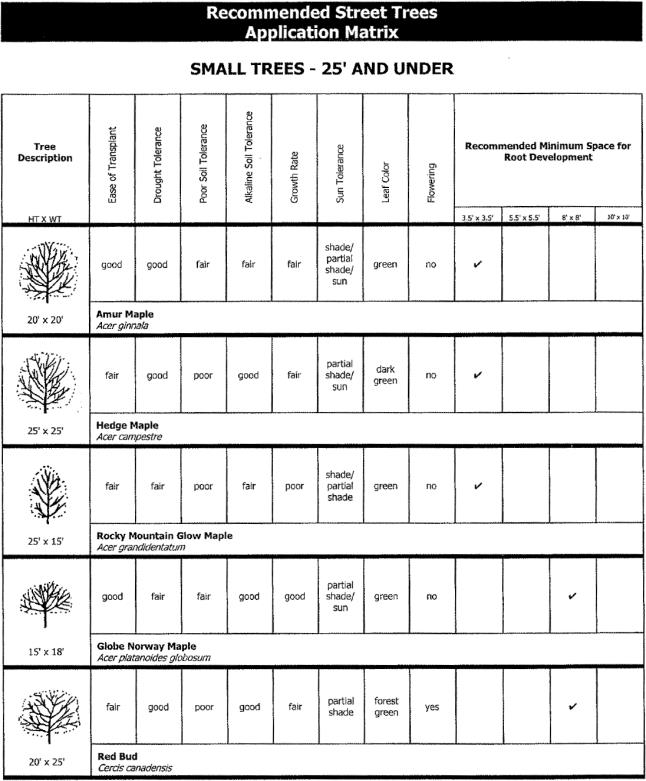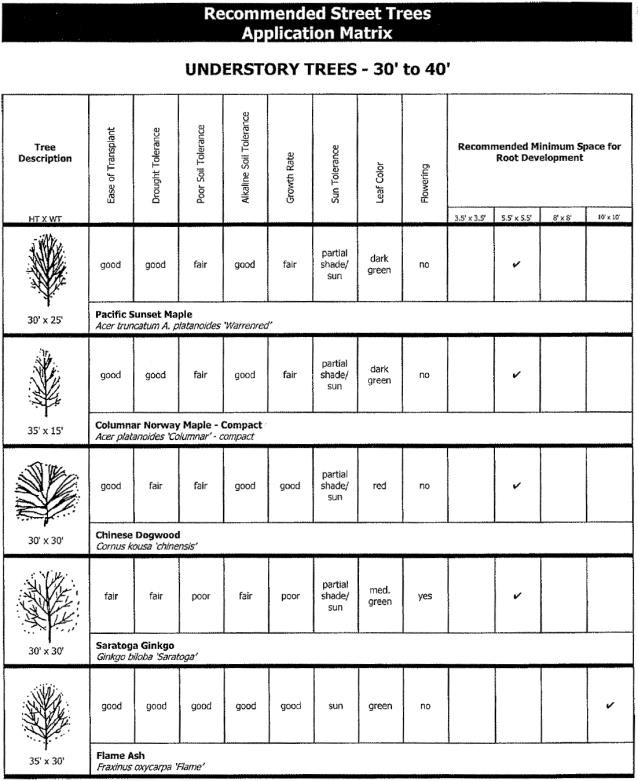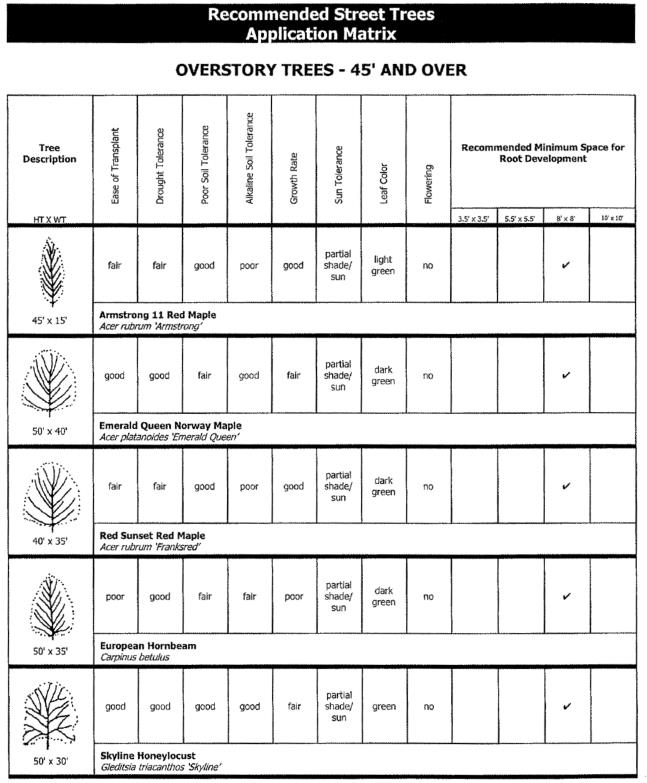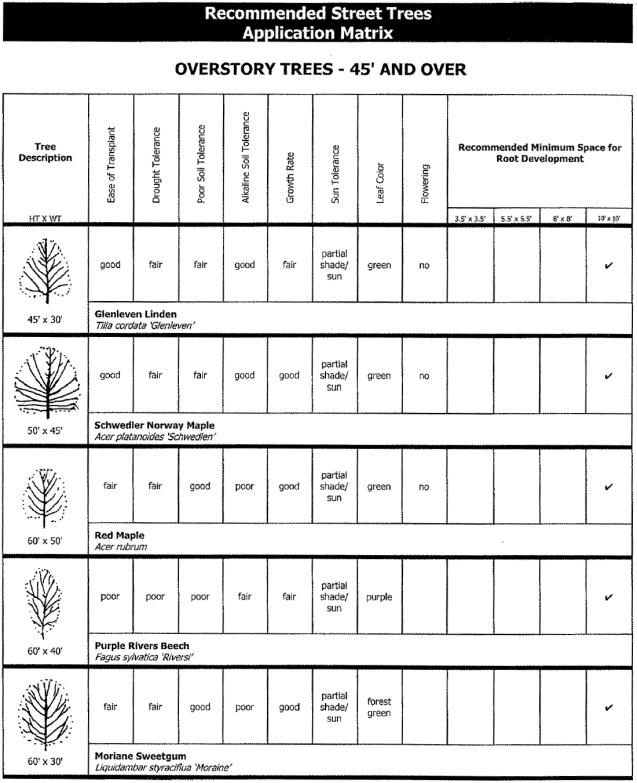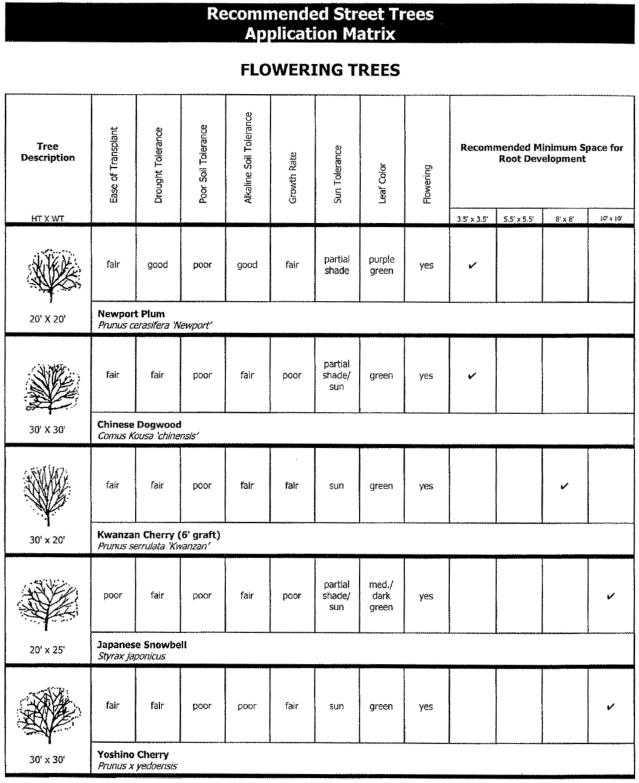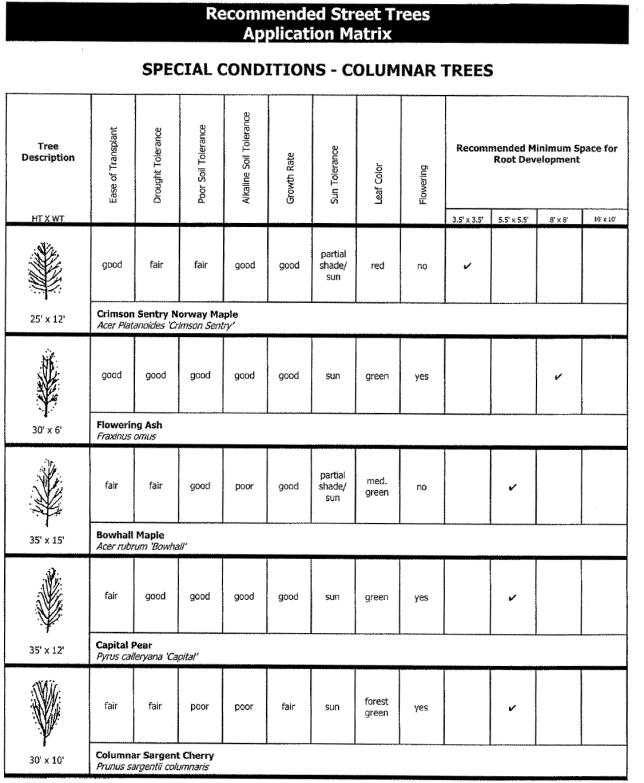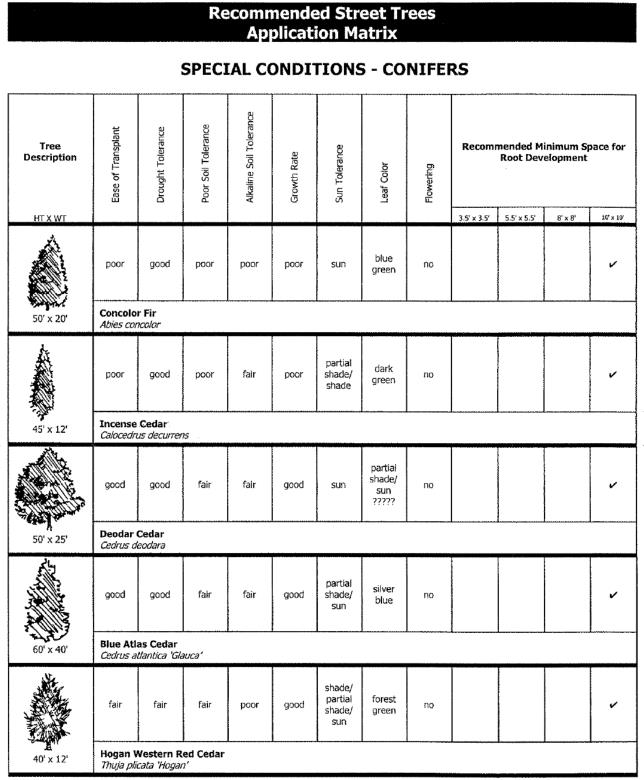Chapter 17.72
LANDSCAPING AND SCREENING
Sections:
17.72.015 Applicability – Approval process.
17.72.035 Location of street trees.
17.72.040 Cut and fill around existing trees.
17.72.050 Replacement of street trees.
17.72.070 Buffering and screening – General provisions.
17.72.080 Buffering and screening requirements.
17.72.090 Setbacks for fences or walls.
17.72.100 Height restrictions.
17.72.110 Screening – Special provisions.
17.72.140 Interior parking lot landscaping.
17.72.010 Purpose.
The purpose of this chapter is to establish standards for landscaping, buffering, and screening of land use within St. Helens in order to enhance the aesthetic environmental quality of the city:
(1) By protecting existing street trees and requiring the planting of street trees in new developments;
(2) Through the use of plant materials as a unifying element;
(3) By using planting materials to define spaces and articulate the uses of specific areas; and
(4) By using trees and other landscaping materials to mitigate the effects of the sun, wind, noise, and lack of privacy by the provision of buffering and screening. (Ord. 2875 § 1.108.010, 2003)
17.72.015 Applicability – Approval process.
(1) The provisions of this chapter shall apply to all development where landscaping is required by this code including the construction of new structures (see SHMC 17.96.020, Applicability of provisions), and to a change of use which increases the on-site parking or loading requirements or which changes the access requirements, except as follows:
(a) Single-dwelling units and duplexes.
(b) Any use not requiring site design review or conditional use permits.
(2) Where the provisions of Chapter 17.96 SHMC, Site Development Review, do not apply, the director shall approve, approve with conditions, or deny a plan submitted under the provisions of this chapter. The decision may be appealed as provided by SHMC 17.24.310(1).
(3) The applicant shall submit a site plan which includes:
(a) Location of underground irrigation system sprinkler heads where applicable;
(b) Location and height of fences, buffers, and screenings;
(c) Location of terraces, decks, shelters, play areas, and common open spaces;
(d) Location, type, size, and species of existing and proposed plant materials; and
(e) A narrative which addresses:
(i) Soil conditions; and
(ii) Erosion control measures that will be used.
(4) The approval standards are the applicable standards contained in this chapter. (Ord. 2875 § 1.108.015, 2003)
17.72.020 General provisions.
(1) Unless otherwise provided by the lease agreement, the owner, tenant, and their agent, if any, shall be jointly and severally responsible for the maintenance of all landscaping which shall be maintained in good condition so as to present a healthy, neat and orderly appearance and shall be kept free from refuse and debris.
(2) All plant growth in landscaped areas of developments shall be controlled by pruning, trimming or otherwise so that:
(a) It will not interfere with the maintenance or repair of any public utility;
(b) It will not restrict pedestrian or vehicular access; and
(c) It will not constitute a traffic hazard because of reduced visibility.
(3) The installation of all landscaping shall be as follows:
(a) All landscaping shall be installed according to accepted planting procedures;
(b) The plant materials shall be of high grade; and
(c) Landscaping shall be installed in accordance with the provisions of this code.
(4) Certificates of occupancy shall not be issued unless the landscaping requirements have been met or other arrangements have been made and approved by the director such as the posting of a bond.
(5) Existing plant materials on a site shall be protected as much as possible:
(a) The developer shall provide methods for the protection of existing plant material to remain during the construction process; and
(b) The plants to be saved shall be noted on the landscape plans (e.g., areas not to be disturbed can be fenced, as in snow fencing which can be placed around individual trees).
(6) Appropriate methods for the care and maintenance of street trees and landscaping materials shall be provided by the owner of the property abutting the rights-of-way unless otherwise required for emergency conditions and the safety of the general public.
(7) The review procedures and standards for required landscaping and screening shall be specified in the conditions of approval during development review and in no instance shall be less than that required for conventional development.
(8) No trees, shrubs, or plantings more than 18 inches in height shall be planted in the public right-of-way abutting roadways having no established curb and gutter. (Ord. 2875 § 1.108.020, 2003)
17.72.030 Street trees.
(1) All development projects fronting on a public or private street, or a private driveway more than 100 feet in length approved after the adoption of the ordinance codified in this code shall be required to plant street trees in accordance with the standards in SHMC 17.72.035.
(2) Certain trees can severely damage utilities, streets, and sidewalks or can cause personal injury. Approval of any planting list shall be subject to review by the director. A list of suggested appropriate tree species is located at the end of this chapter. Additional or alternative tree species also may be recommended by the applicant or determined by the director based on information provided in adopted city plans, policies, ordinances, studies or resolutions. Proposals by the applicant shall require approval by the director. (Ord. 3181 § 4 (Att. C), 2015; Ord. 2875 § 1.108.030, 2003)
17.72.035 Location of street trees.
(1) Landscaping in the front and exterior side yards shall include trees with a minimum caliper of two inches at four feet in height as specified in the requirements stated in subsection (2) of this section.
(2) The specific spacing of street trees by size of tree shall be as follows:
(a) Small or narrow stature trees (under 25 feet tall and less than 16 feet wide branching) shall be spaced no greater than 20 feet apart;
(b) Medium sized trees (25 to 40 feet tall, 16 to 35 feet wide branching) shall be spaced no greater than 30 feet apart;
(c) Large trees (over 40 feet tall and more than 35 feet wide branching) shall be spaced no greater than 40 feet apart;
(d) Except for signalized intersections as provided in SHMC 17.72.060(3), trees shall not be planted closer than 20 feet from a street intersection, nor closer than two feet from private driveways (measured at the back edge of the sidewalk), fire hydrants, or utility poles in order to maintain visual clearance;
(e) No new utility pole location shall be established closer than five feet to any existing street tree;
(f) Tree pits shall be located so as not to include services (water and gas meters, etc.) in the tree well;
(g) On-premises services (water and gas meters, etc.) shall not be installed within existing tree well areas;
(h) Street trees shall not be planted closer than 20 feet to light standards;
(i) New light standards shall not be positioned closer than 20 feet to existing street trees except when public safety dictates, then they may be positioned no closer than 10 feet;
(j) Trees shall be planted at least two feet from the face of the curb;
(k) Where there are overhead power lines, the street tree species selected shall be of a type which, at full maturity, will not interfere with the lines; and
(l) Trees shall not be planted within two feet of any permanent hard surface paving or walkway:
(i) Space between the tree and the hard surface may be covered by a nonpermanent hard surface such as grates, bricks on sand, paver blocks, and cobblestones; and
(ii) Sidewalk cuts in concrete for tree planting shall be at least four feet by four feet to allow for air and water into the root area.
(3) Trees, as they grow, shall be pruned to provide at least eight feet of clearance above sidewalks and 13 feet above local street, 15 feet above collector street, and 18 feet above arterial street roadway surfaces. (Ord. 2875 § 1.108.035, 2003)
17.72.040 Cut and fill around existing trees.
(1) Existing trees may be used as street trees if no cutting or filling takes place within the dripline of the tree unless an exception is approved by the director.
(2) An exception will be approved if:
(a) The ground within the dripline is altered merely for drainage purposes; and
(b) It can be shown that the cut or fill will not damage the roots and will not cause the tree to die. (Ord. 2875 § 1.108.040, 2003)
17.72.050 Replacement of street trees.
(1) Existing street trees removed by development projects or other construction shall be replaced by the developer with those types of trees approved by the director.
(2) The replacement trees shall be of a size and species similar to the trees that are being removed unless lesser sized alternatives are approved by the director. (Ord. 2875 § 1.108.050, 2003)
17.72.060 Exemptions.
(1) Modifications to the street tree requirements or exemptions to the requirements may be granted by the director on a case-by-case basis.
(2) Exemptions shall be granted if it can be documented that one or more of the following applies to the site:
(a) The location of a proposed tree would cause potential problems with existing utility lines;
(b) The tree would cause visual clearance problems;
(c) There is not adequate space in which to plant street trees within the public right-of-way; or
(d) The ground conditions within the public right-of-way are unable to support street trees.
(3) The director may allow trees closer to specified intersections which are signalized, provided the provisions of Chapter 17.76 SHMC, Visual Clearance Areas, are satisfied.
(4) If one or more conditions described in subsection (2) of this section are shown to exist on the site, the director may require the following to fulfill the street tree requirements of this chapter:
(a) A landscaping easement outside the public right-of-way for the purposes of accommodating street trees. The location of the landscaping easement shall be located on site. A public utility easement may be used for this purpose.
(b) An applicant may, with the consent of the director, elect to compensate the city for costs commensurate with the number of street trees that would have otherwise been required for the site. The fee, established by resolution of the city council, will be generally based on the city’s street tree list in this chapter and market value of the tree(s). (Ord. 3181 § 4 (Att. C), 2015; Ord. 3150 § 3 (Att. B), 2011; Ord. 2875 § 1.108.060, 2003)
17.72.070 Buffering and screening – General provisions.
(1) It is the intent that these requirements shall provide for privacy and protection and reduce or eliminate the adverse impacts of visual or noise pollution at a development site, without unduly interfering with the view from neighboring properties or jeopardizing the safety of pedestrians and vehicles.
(2) Buffering and screening are required to reduce the impacts on adjacent uses which are of a different type in accordance with the matrix in this chapter. The owner of each proposed development is responsible for the installation and effective maintenance of buffering and screening.
(3) In lieu of these standards, a detailed buffer area landscaping and screening plan may be submitted for the director’s approval as an alternative to the buffer area landscaping and screening standards, provided it affords the same degree of buffering and screening as required by this code. (Ord. 2875 § 1.108.070, 2003)
17.72.080 Buffering and screening requirements.
(1) A buffer consists of an area within a required yard adjacent to a shared property line and having a depth equal to the amount specified in the buffering and screening matrix and containing a length equal to the length of the property line of the abutting use or uses.
(2) A buffer area may only be occupied by utilities, screening, sidewalks and bikeways, and landscaping. No buildings, accessways, or parking areas shall be allowed in a buffer area except where an accessway has been previously approved by the city.
(3) A fence, hedge, or wall, or any combination of such elements which is located in any yard is subject to the conditions and requirements of this section.
(4) The minimum improvements within a buffer area shall consist of the following:
(a) At least one row of trees shall be planted. They shall be not less than 10 feet high for deciduous trees and five feet high for evergreen trees at the time of planting. Spacing for trees shall be as follows:
(i) Small or narrow stature trees, under 25 feet tall or less than 16 feet wide at maturity, shall be spaced no further than 15 feet apart; and
(ii) Medium sized trees, between 25 to 40 feet tall and with 16 to 35 feet wide branching at maturity, shall be spaced no greater than 30 feet apart; and
(iii) Large trees, over 40 feet tall and with more than 35 feet wide branching at maturity, shall be spaced no greater than 30 feet apart.
(b) In addition, at least 10 five-gallon shrubs or 20 one-gallon shrubs shall be planted for each 1,000 square feet of required buffer area; and
(c) The remaining area shall be planted in lawn, ground cover, or spread with bark mulch.
(5) Where screening is required, the following standards shall apply in addition to those required for buffering:
(a) A hedge of narrow or broadleaf evergreen shrubs shall be planted which will form a four-foot continuous screen within two years of planting; or
(b) An earthen berm planted with evergreen plant materials shall be provided which will form a continuous screen six feet in height within two years. The unplanted portion of the berm shall be planted in lawn, ground cover or bark mulch; or
(c) A five-foot or taller fence or wall shall be constructed to provide a continuous sight-obscuring screen.
(6) Buffering and screening provisions shall be superseded by the vision clearance requirements as set forth in Chapter 17.76 SHMC.
(7) When the use to be screened is downhill from the adjoining zone or use, the prescribed heights of required fences, walls, or landscape screening shall be measured from the actual grade of the adjoining property. In this case, fences and walls may exceed the permitted six-foot height at the discretion of the director as a condition of approval. When the grades are so steep so as to make the installation of walls, fences or landscaping to the required height impractical, a detailed landscape/screening plan shall be submitted for approval.
(8) Fences and Walls.
(a) Fences and walls shall be constructed of any materials commonly used in the construction of fences and walls such as wood or brick, or otherwise acceptable by the director;
(b) Such fence or wall construction shall be in compliance with other city regulations; and
(c) Chain link fences with slats shall qualify for screening. However, chain link fences without slats shall require the planting of a continuous evergreen hedge to be considered screening.
(9) Hedges.
(a) An evergreen hedge or other dense evergreen landscaping may satisfy a requirement for a sight-obscuring fence where required subject to the height requirement in SHMC 17.72.090(2)(a) and (b);
(b) Such hedge or other dense landscaping shall be properly maintained and shall be replaced with another hedge, other dense evergreen landscaping, or a fence or wall when it ceases to serve the purpose of obscuring view; and
(c) No hedge shall be grown or maintained at a height greater than that permitted by these regulations for a fence or wall in a vision clearance area as set forth in Chapter 17.76 SHMC. (Ord. 3264 § 2 (Att. A), 2021; Ord. 2875 § 1.108.080, 2003)
17.72.090 Setbacks for fences or walls.
(1) No fence or wall shall be constructed which exceeds the standards in subsection (2) of this section except when the approval authority, as a condition of approval, allows that a fence or wall be constructed to a height greater than otherwise permitted in order to mitigate against potential adverse effects. For residential uses, a fence may only exceed the height standards if approved by a variance.
(2) Fences or walls:
(a) May not exceed four feet in height in a required front yard along local or collector streets or six feet in all other yards and, in all other cases, shall meet vision clearance area requirements (Chapter 17.76 SHMC);
(b) Are permitted up to six feet in height in front yards adjacent to any designated arterial or street. For any fence over three feet in height in the required front yard area, permission shall be subject to review of the location of the fence or wall;
(c) All fences or walls shall meet vision clearance area requirements (Chapter 17.76 SHMC);
(d) All fences or walls greater than six feet in height shall be subject to building official approval. (Ord. 3144 § 2 (Att. A), 2011; Ord. 2875 § 1.108.090, 2003)
17.72.100 Height restrictions.
(1) The prescribed heights of required fences, walls, or landscaping shall be measured from the actual adjoining level of finished grade, except that where parking, loading, storage, or similar areas are located above finished grade, the height of fences, walls, or landscaping required to screen such areas or space shall be measured from the level of such improvements.
(2) An earthen berm and fence or wall combination shall not exceed the six-foot height limitation for screening. (Ord. 2875 § 1.108.100, 2003)
17.72.110 Screening – Special provisions.
(1) Screening of Parking and Loading Areas.
(a) Screening of parking for single and duplex attached and detached dwellings is not required.
(b) Screening of parking (larger than three spaces) and loading areas (larger than 400 square feet) is required. The specifications for this screening are as follows:
(i) Landscaped parking areas shall include special design features which effectively screen the parking lot areas from view. These design features may include the use of landscaped berms, decorative walls, and raised planters. Berms, planters, and other forms of vegetative landscaping are permitted for screening that fronts US 30. Walls are prohibited for screening that fronts US 30;
(ii) Landscape planters may be used to define or screen the appearance of off-street parking areas from the public right-of-way; and
(iii) Materials to be installed should achieve a balance between low-lying and vertical shrubbery and trees.
(2) Screening of Service Facilities. Except for single-dwelling units and duplexes, service facilities such as gas meters and air conditioners which would otherwise be visible from a public street, customer or resident parking area, any public facility or any residential area shall be screened from view by placement of a solid wood fence or masonry wall between five and eight feet in height or evergreens already to correct height minimums. All refuse materials shall be contained within the screened area. Rooftop service facilities and equipment shall be screened from view from adjacent streets and adjacent properties in one of the following ways:
(a) A parapet wall of adequate height;
(b) A screen around the equipment that is made of a primary exterior finish material used on other portions of the building; or
(c) Set back such that it is not visible from the public street(s) and adjacent properties.
(3) Screening of Swimming Pools. All swimming pools shall be enclosed as required by the applicable building code as administered by the building official.
(4) Screening of Refuse Containers Required. Except for one- and two-unit dwellings, any refuse container or refuse collection area which would be visible from a public street, parking lot, residential or commercial area, or any public facility such as a school or park shall be screened or enclosed from view by placement of a solid wood fence, masonry wall or evergreen hedge.
(5) Outdoor storage areas shall be landscaped and screened in accordance with SHMC 17.72.080(5)(a) through (c).
(6) The approval authority may, at their discretion, make variations from this rule when topography makes the screening rules unreasonable. (Ord. 3181 § 4 (Att. C), 2015; Ord. 3164 § 3 (Att. B), 2012; Ord. 2875 § 1.108.110, 2003)
17.72.120 Revegetation.
(1) Where natural vegetation has been removed through grading in areas not affected by the landscaping requirements and that are not to be occupied by structures, such areas are to be replanted as set forth in this section to prevent erosion after construction activities are completed.
(2) Methods of Revegetation. Acceptable methods of revegetation include hydromulching or the planting of rye grass, barley, or other seed with equivalent germination rates, and:
(a) Where lawn or turf grass is to be established, lawn grass seed or other appropriate landscape cover is to be sown at not less than four pounds to each 1,000 square feet of land area;
(b) Other revegetation methods offering equivalent protection may be approved by the approval authority;
(c) Plant materials are to be watered at intervals sufficient to ensure survival and growth; and
(d) The use of native plant materials is encouraged to reduce irrigation and maintenance demands. (Ord. 2875 § 1.108.120, 2003)
17.72.130 Buffer matrix.
(1) The buffer matrix (Figure 13) shall be used in calculating widths of buffering and screening to be installed between proposed uses and abutting zoning districts or specified types of streets.
(2) An application for a variance to the standards required in Figure 13 shall be processed in accordance with Chapter 17.108 SHMC.
|
|
PROPOSED USES |
||||||||||
|---|---|---|---|---|---|---|---|---|---|---|---|
|
Existing Abutting Use of Zoning District |
Attached Dwelling Units – 1 story |
Attached Dwelling Units – 2 stories or more |
Mobile Home Parks |
Commercial Uses |
Industrial Park Use |
Light Industrial Use* |
Heavy Industrial Use* |
Any Parking Lot |
|||
|
R-5 |
AR |
R-5 |
AR |
4 – 50 spaces |
51 or more spaces |
||||||
|
Detached Single-Family R-10, R-7, R-5 |
10′ |
10′ |
10′ |
10′ |
10′ |
20′ |
20′ |
30′ |
40′ |
10′ |
20′ |
|
Attached Dwelling Units |
0′ |
10′ |
10′ |
10′ |
10′ |
20′ |
20′ |
30′ |
40′ |
10′ |
20′ |
|
Attached Dwelling Units |
10′ |
10′ |
10′ |
10′ |
10′ |
20′ |
20′ |
30′ |
40′ |
10′ |
20′ |
|
Mobile Home Parks |
10′ |
10′ |
10′ |
10′ |
10′ |
20′ |
20′ |
30′ |
40′ |
10′ |
20′ |
|
Arterial Street |
10′ |
10′ |
10′ |
10′ |
10′ |
0′ |
20′ |
0′ |
20′ |
0′ |
|
|
US 30 |
10′ |
10′ |
10′ |
10′ |
10′ |
0′ |
20′ |
0′ |
20′ |
5′ |
|
|
Commercial Uses |
10′ |
10′ |
10′ |
10′ |
10′ |
0′ |
20′ |
0′ |
20′ |
0′ |
|
|
Industrial Park |
20′ |
20′ |
20′ |
20′ |
20′ |
10′ |
0′ |
0′ |
10′ |
0′ |
|
|
Light Industrial |
25′ |
25′ |
25′ |
25′ |
25′ |
10′ |
0′ |
0′ |
0′ |
0′ |
|
|
Heavy Industrial |
40′ |
40′ |
40′ |
40′ |
40′ |
20′ |
20′ |
0′ |
0′ |
0′ |
|
|
Any Parking Lot with |
10′ |
10′ |
10′ |
10′ |
10′ |
0′ |
0′ |
0′ |
0′ |
0′ |
|
|
Any Parking Lot with |
10′ |
10′ |
10′ |
10′ |
10′ |
0′ |
0′ |
0′ |
0′ |
0′ |
|
“S” indicates screening required
* May require up to 150 ft. buffer if off-site impacts are significant
(Ord. 3181 § 4 (Att. C), 2015; Ord. 2875 § 1.108.130, 2003)
17.72.140 Interior parking lot landscaping.
(1) All parking areas with more than 20 spaces shall provide landscape islands with trees that provide a canopy effect and break up the parking area into rows of not more than seven contiguous parking spaces.
(2) Landscape islands and planters shall have dimensions of not less than 48 square feet of area and no dimension of less than six feet, to ensure adequate soil, water, and space for healthy plant growth.
(3) All required parking lot landscape areas not otherwise planted with trees must contain a combination of shrubs and groundcover plants so that, within two years of planting, not less than 50 percent of that area is covered with living plants.
(4) The landscaping shall be protected from vehicular damage by some form of wheel guard or curb permanently fixed to the ground. (Ord. 3181 § 4 (Att. C), 2015)
